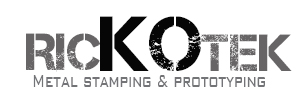During the process of deep drawing, sheet metal blanks are pushed into a die cavity by a punch. This produces a part that is contoured. If a part’s depth is half its diameter or more, it qualifies as deep drawn. The term “general stamping” describes parts that do not meet these criteria.
The process of deep drawn stamping is used frequently. Many different household items are created via this process, including kitchen sinks, soup cans, fire extinguishers, and casings for batteries. If a part is very complex, it’s possible that the deep drawing process will have more than one drawing operation.
Issues With Wrinkling
Sheet metal wrinkling is a common problem that occurs during the deep drawing process. When this occurs, it typically happens in the sheet metal’s flange or wall. Both tangential compressive and radial drawing stress are placed on the part when stamping occurs, and this can lead to wrinkling. However, with an appropriately designed deep drawing system and stamped part, wrinkling can be avoided.
Factors That Can Cause Wrinkles
Wrinkling can be caused by many different factors, such as:
1. Pressure from the blank holder
2.The radius and depth of the die cavity
3. Friction between the blank and other parts, such as the punch, blank holder or die cavity
4. Clearances between the blank holder and other parts
5. The shape and thickness of the blank
6. The speed of the punch
7. The geometry of the final part
There are additional factors to take into consideration as well, like the temperature of the die and the blank’s metal allow. All of these factors can impact the drawing process, and even minor variations can increase the risk of cracking or wrinkling.
As its name might suggest, the blank holder is what holds the blank securely while the blank is pushed into the die cavity by the punch. It’s why the sheet metal is able to form into the correct shape rather than just being pulled into the die cavity.
With that said, the blank holder doesn’t grip the blank’s edges in an uncompromising way. A rigid grip could cause the cup wall to experience tearing. Instead, the holder is designed to let the blank slide. It produces a frictional force between the blank and its holder. This force can be applied in many different ways, such as nitrogen, air, or hydraulic cushions.
The deeper the die cavity is, the further the sheet metal has to be pulled, which means the risk for wrinkling increases with a deeper die cavity. It’s important to take this into consideration when determining the depth of a die cavity.
The way the sheet metal flows towards the die cavity is controlled by the radii degrees of the die cavity edges and the punch. If the punch’s radii are too big, or if the edges of the die cavity are oversized, it could cause wrinkling in the cup wall to take place. When the radii aren’t large enough, however, the risk for tearing increases.
Preventing Wrinkles With A Blank Holder
The easiest way to avoid wrinkling during the deep drawing process is to use the right blank holder. During this process, the blank holder should provide steady pressure.
With that said, it’s possible to apply variable pressure as well using a hydraulic or pneumatic cushion for the blank holder. This means that pressure can shift during the process. When this technique is used, the depth of a die cavity can increase.
A die cushion that’s numerically controlled can also deliver the same effect. Ideally, the force should be significant at first and then change throughout the process.
The pressure decreases when the material is pulled towards the die cavity, then gradually increases as the process is completed. With a die cushion, crackling and wrinkling can be avoided, even with a higher die cavity depth.
Avoiding Wrinkling Through Die Cavity Design
It’s also possible to reduce the risk of wrinkling when the design of the die cavity and punch are optimized. For example, the risk of wrinkles is lower when the flange radius is large enough to avoid cracking, but not any bigger than that. It’s also easier to avoid wrinkling when the part is less complex. You may want to consider a drawing process with multiple steps, as it offers a number of benefits.
The risk of wrinkling will be decreased when the blank’s geometry is designed to reduce the amount of excess material. There’s a natural grain structure to a blank, which means the amount of stress placed on the sheet metal can change based on grain orientation and the way a die is designed. If you adjust the grain so that less stress takes place during deep drawing, you can avoid these kinds of problems.
What Else Should You Take Into Consideration?
It’s possible to improve the performance of every component by working to improve surface conditions. As an example, you can use a lubricant to decrease the amount of friction between the sheet metal, die cavity, and bunch. Both wet and dry lubricants, like films, can be used. As a rule, you’ll want to apply a lubricant to your blank before the drawing process begins.
It’s becoming increasingly common to use films during deep drawing. This is because films don’t require that parts are be washed after they are fabricated. Since a lubricant makes it easier for metal to flow towards the die cavity, you’ll want to make sure you adjust the amount of force used during the process.
Previously, the design of die and parts were improved via a trial and error process. These days, however, it’s possible to create deep drawing simulations so that the appropriate designs can be created via finite element modeling and computer-aided design. This leads to lower tooling costs and a smoother design process overall.

